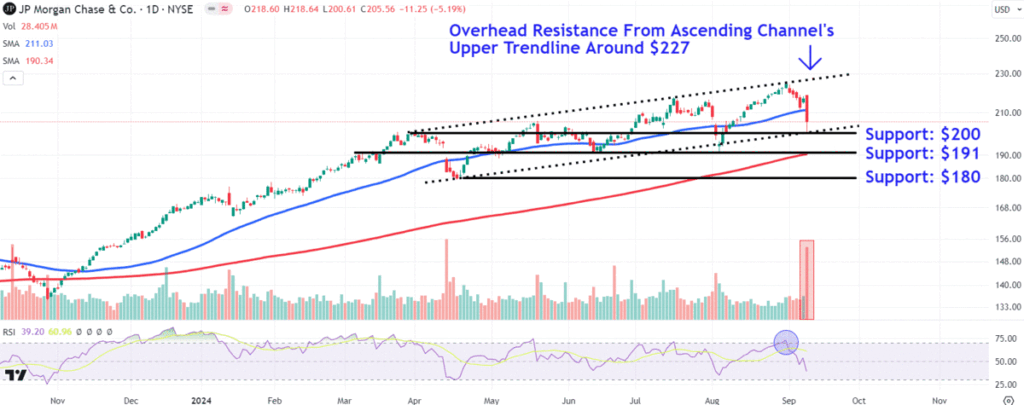Key Takeaways
-
JPMorgan shares dropped more than 5% on Tuesday after the bank’s president said Wall Street’s expectations for net interest income and expenses in 2025 were overly optimistic amid impending interest rate cuts and lingering inflation.
-
Since the start of September selling has intensified in the stock, with Tuesday’s drop occurring on the highest trading volume since mid April, indicating active participation by larger market participants.
-
Investors should monitor key lower price levels on JPMorgan’s chart at $200, $191, and $180, while also eyeing potential overhead resistance around $227.
JPMorgan Chase (JPM) shares dropped more than 5% on Tuesday, recording their largest one-day decline since June 2020, after the bank’s president said Wall Street’s expectations for net interest income and expenses in 2025 were overly optimistic amid impending interest rate cuts and lingering inflation.
The bank’s stock, which trades around 21% higher since the start of the year through Tuesday’s close, has benefited from persistently high lending rates in 2024, helping it earn favorable yields between what it pays depositors and earns by lending money or investing in securities.
Below, we’ll take a closer look at JPMorgan’s chart and apply technical analysis to identify important price levels to watch.
September Selling
JPMorgan shares have trended higher within an ascending channel since early April, helping to establish easily identifiable support and resistance areas.
However, a late-August rally into the pattern’s upper trendline. which coincided with an overbought relative strength index (RSI) reading and a new record high, has marked a key turning point in stock.
Since the start of September selling has intensified, with Tuesday’s drop occurring on the highest trading volume since mid April, indicating active participation by larger market participants, such as institutional investors and pension funds. The stock fell 5.2% to close at $205.56 on Tuesday.
Lower Chart Levels to Watch Out For
Looking ahead, investors should monitor three key lower areas on JPMorgan’s chart that may come into play if selling continues.
The first sits at $200 near the channel’s lower trendline, a location on the chart where the price may also find support from a trendline linking the prominent early April swing high with a range of comparable trading levels over the past five months, including Tuesday’s low.
A fall below this level could see the shares in the Dow component revisit the $191 level, where they may attract buying interest near a brief period of consolidation that formed on the chart towards the end of the stock’s trending move from October to March. This area also aligns with the May, June and August lows, along with the 200-day moving average.
A more significant correction could trigger a decline to around $180, an area likely to find support near the mid-April pullback low. Such a drop would represent a 12% fall from Tuesday’s closing price.
Key Overhead Price Level to Monitor
If JPMorgan shares resume their move higher, investors should monitor how the price reacts to the ascending channel’s upper trendline, currently sitting around $227. A volume-backed breakout above the pattern could see the shares resume their longer-term uptrend.
The comments, opinions, and analyses expressed on Investopedia are for informational purposes only. Read our warranty and liability disclaimer for more info.
As of the date this article was written, the author does not own any of the above securities.
Read the original article on Investopedia.
Read the full article here

